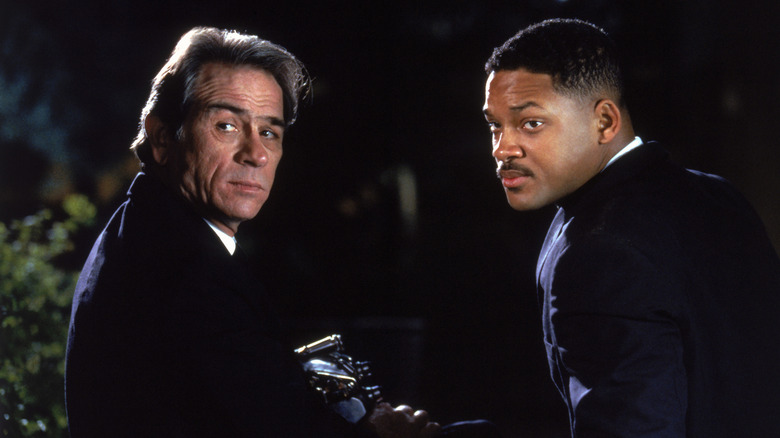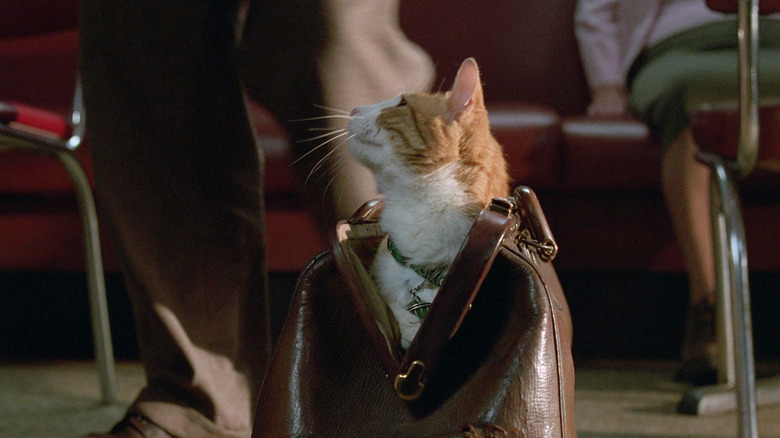Men In Black's Original Confusing Plot Was Reworked Thanks To Alien Subtitles
We may receive a commission on purchases made from links.
"Men in Black" is a brisk summer blockbuster that does the unthinkable, especially in today's over-explicative superhero movie wasteland: it doesn't repeat information. It moves from plot point to plot point cleanly and clearly in a way that, judging from the box office, plays for all four commercial quadrants. It flatters the viewer by treating them as smart and perceptive, and rewards them with a tremendously satisfying finale. I can't think of too many studio tentpoles that pull this off with such glee.
Of course, no movie goes through production without its share of hiccups, and very few are shot exactly as written on the page. Sometimes, when you begin screening your movie for test audiences, you notice that seemingly can't-miss laugh lines don't get laughs, or a major action set piece feels out of place, or, worst of all, viewers are having trouble following the plot.
During the test screening process for "Men in Black," newly appointed Sony president of production (and "Hackers" supporter) John Calley had this problem with the film, and pointed to its good-not-great score of 78 out of 100 as evidence that something wasn't clicking with the audience. Surprisingly, in Barry Sonnenfeld's new memoir "Best Possible Place, Worst Possible Time: True Stories from a Career in Hollywood," the famously contentious director found himself agreeing with his executive. And he had just the solution. All he had to do was convince another executive that his idea would work.
It doesn't have to be elegant, it just has to work
In his memoir, Sonnenfeld remembers Calley opining, "I wish the plot was just a little easier to follow and had bigger stakes." His primary issue was the notion of the film's two warring alien races, the Arquillians and the Bugs, were engaged in a war on Earth that held no consequences for our planet.
Sonnenfeld was prepared for this note. "There's a way to change the plot to make it more visceral," he said to Calley. "And it won't require any additional shooting."
Sonnenfeld flew into action. He explained how the Arquillians and the Bugs are in a race to possess Orion's Belt. If the former is able to retrieve the object, the universe will be in good shape; if the Bugs get it, they'll be able to wreak havoc throughout space and time. As Sonnenfeld put it at the time:
"'The good alien planet, the protector of Orion's Belt, with their ambassadors dead, wants the Men in Black to find and deliver it to them or they'll have to destroy Earth [and Orion's Belt] rather than let Edgar Bug have it. The big board at MIB Headquarters can show an alien attack ship waiting to blow up Earth.'"
And all they had to do was ADR this into an existing scene with two Arquillian ambassadors.
"Too simple," countered Walter F. Parkes, who was producing the film with his partner Laurie MacDonald and their DreamWorks boss Steven Spielberg. "I like it," said Calley.
Parkes could've caused trouble here, but Sonnenfeld had one very important thing working in his favor: they were very close to their July 2, 1997 opening day, so the next test screening would probably be one of their last, if not their very last. How did it work?
They scored an 89 out of 100. Sonnenfeld got his way, and all Parkes could do was grouse (and remind himself he co-wrote the brilliant "Sneakers"). At the end of the day, I can't imagine anyone objecting to this clever tweak that adds a touch of ticking-clock tension to the conclusion of this classic sci-fi adventure. Is it simplistic? Yes, but the rest of the movie plays so well that you cut it some slack. That's something you can't say about many tentpole movies nowadays.

